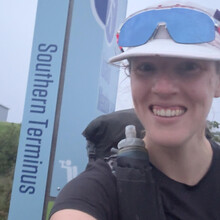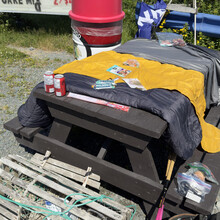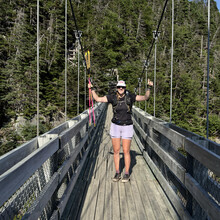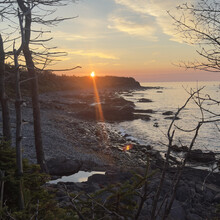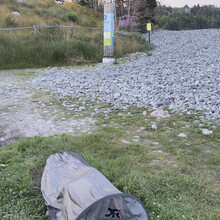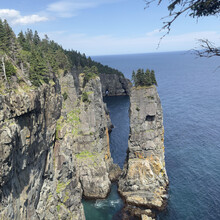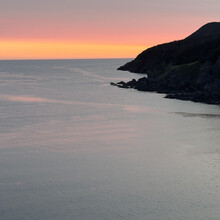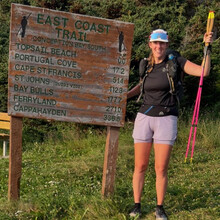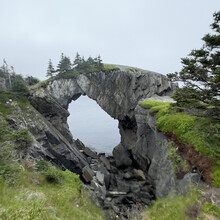In the spring of 2023, I decided, on a whim, to attempt to fastpack the East Coast Trail; 336 km of wilderness paths along North America’s easternmost coastline. It is a wild and rugged trail located in the Avalon peninsula of Newfoundland, Canada. I had 10 days off of work in June and with only a few weeks to prepare, I frantically tried to get some training in, assemble a pack with decent equipment and put together daily food bags.
I did minimal research on the trail or the area. Turns out it rained the entire time I was on the trail, it was cold and windy and the trails never got a chance to dry out from the winter. They were not trails, but rather rivers and lakes of mud. My lack of preparation for such conditions resulted in me pulling out of the trail on day 4, just passed the halfway mark, mentally destroyed, with feet completely blistered and an injured hip.
After my expedition around the Eye of Quebec this winter, I was dealing with health problems including a possible hernia and low iron levels and so training for the East Coast trail did not come back onto my radar until late in the Spring. However, my base training was much better than it was last year and once I was cleared by my doctor to go on expedition again, I started dreaming about going back to Newfoundland. The very day I thought about attempting the East Coast Trail for a second time, I took out my fastpack, loaded it with random items I found in my equipment wardrobe and went out for a run in the pouring rain. Training was starting again and this time I was determined to show up to the start as ready as I could be. In the hopes of avoiding adverse weather, I selected a week in mid July for my time off of work. This also allowed me more time to test out my gear, get my body in shape and dial down the food I wanted to bring.
Because I only had limited time off of work and considering travel time to get to Newfoundland, I had a 7 day window to complete the trail. I also wanted to do it as fast as I possibly could and thought if I pushed myself really hard, 6 days was realistic. The East Coast trail consists of 25 individual paths of varying lengths and difficulty, linked together by community walks. My goal was to take it one trail at a time, one road section at a time and go everyday from sunrise to sunset. I searched the fastest known time website to see if anyone had submitted their time for the entire ECT and found multiple entries for the South portion and for the North portion, but none for the integral trail. Obviously, numerous people complete this trail every year, and I know some people have fastpacked it as well, but no one had submitted the route or their time to the FKT website. I decided my main goal would be to submit my time, and try to make it one that would be hard to beat. As per the FKT rules, I chose to put in a self-supported effort, meaning I would be self-reliant for most of my food with a resupply drop bag half way and I would camp on the trail. I also planned on purchasing food from convenience stores and the occasional restaurant.
After multiple flight delays, I arrived at my AirBnb in St-John’s in the middle of the night, tired but excited for my chance at redemption. The next day, I made last minute food purchases, stuffed my face with all the food I could ingest to continue my carb loading and got a ride from a couple of Newfoundland locals that were nice enough to drive me to the trailhead in Cappahayden, the southern terminus of the East Coast Trail. It is a small community of barely 30 people and has no cell service. One of the ladies that gave me a ride had a property about 200m away from the trailhead and suggested I camp on her lawn and use her wifi, which was a welcome treat to be able to communicate with my family on the last evening before my adventure started. I taped up my feet and my back in the areas I knew were prone to blisters or chafing. I made my overnight oats for the next morning and I took shelter from the raging mosquitoes in my bivy around 7pm. I barely slept that night, having eaten too much during the day and too excited for the week ahead.
Day 1 – 68.2km Cappahayden to Cape Broyle Head Trailhead
On day 1, my alarm went off at 4:30am. I packed up my equipment, rearranged my backpack one last time and made my way to the trailhead while eating a poptart and my overnight oats through a small hole I cut in the ziploc bag they were stored in. Breakfast of champions. I took the traditional picture in front of the Southern terminal sign and at 5:11am, I started my watch and started running under a covered sky and a light drizzle. Within minutes of running through the long grass along the coast, my feet were soaked and it immediately brought me back to last year where I experienced non-stop rain for the 4 days I was out on the trail. Keeping my feet healthy was going to have to be a priority as it was a huge limiting factor last year.
Island Meadow and Bear Cove Point trails were wet and treated me to mud baths from the beginning. With my legs sinking into the mud up to my knees at multiple points during the day, I knew completing the entire trail was far from a given and I would have to dig deep mentally to get through these extremely remote and gnarly trails.
At exactly 40km, I arrived at Berry Head sea arch on Spurwink Island trail, one of the most breathtaking features along the entire ECT. Last year I got to that point in rough shape and in a tough spot mentally, but this year, I felt awesome. I continued to push on to the town of Aquaforte where I passed my first camping spot from last year and thought there is absolutely no way I am stopping here. I still had so much daylight and energy in me. So I kept going. The rain slowly started letting up and the sun came out. The rain never made another appearance for the entire week. The next trail was supposed to be Sounding Hills path but because of a conflict with the landowner at the trailhead, the right of passage has been revoked permanently and I had to run along the highway for 6km. When I arrived at the next community in Ferryland around dinner time, I stopped in at a restaurant for fish and chips and a Pepsi before continuing for another 8km on Caplin Bay path to the end of the road in Calvert. I decided to set up camp for the night at the Cape Broyle Head trailhead, next to a small pond, under the cover of a huge pine tree. Rocked by the sound of the frogs, it took me about 5 seconds to fall asleep.
Day 2 – 54.1km Cape Broyle Head to Beaches trailhead
Day 2 started off with one of the most difficult sections of the entire ECT. It took me over 5 hours to complete 17km. I felt sluggish, didn’t have any energy going up the hills, felt I was hesitant on the downhills. My pack felt heavy on my back, my shoulders were tender and I could feel rubbing on my back outside of the tape I had put on to prevent chafing. The relentless and steep ups and downs really broke me and I came out of this trail in bad shape mentally and physically. It was also very hot and humid and I had a hard time getting food in me. I passed by a convenience store and grabbed two cans of Coke and a Mr.Freeze. I layed out my camping equipment to dry out from the condensation of the previous night and I knew the only way to get over this low point was to keep moving forward. The next section included Brigus Head, Flamber Head and LaManche Village paths. I put my head down and just kept putting one foot in front of the other, taking minimal breaks, always moving forward, always in motion, still not eating or drinking nearly enough.
One of the main difficulties of the southern section of the trail, apart from distance and elevation, is the lack of trail maintenance. Here, I am not complaining about the mud or the technicity or the rocks and roots, but rather the pure bushwalking required in certain sections. For what seemed like hours and hours, I had to push my way through dense trees with branches hitting me in the face constantly. My glasses were worn not to protect my eyes from the sun but rather from the trees. I would bend down, fold myself in half, walk like a hobbit to try and dodge the higher branches but then I would be tugged backwards after the branches would get caught in my pack and miss falling on my back about a thousand times.
When I emerged from the solitude and isolation of the trails onto LaManche suspension Bridge, I was met with a contrasting scenery of weekend warriors, party boats riding the river wave and tourists lining up to take their picture on the bridge. So I did the same thing anyone in my situation would have done. I took a picture of a couple and then asked them to take my picture before continuing on the other side and back into the wilderness. The next 12 kilometers were easy trails and community walks and even though I had almost no energy left in the tank, I still had a few hours of daylight left so I took it easy, walked and slowly shuffled for a couple hours before reaching Beaches trailhead. I was a little disappointed I didn’t make it to Bay Bulls or Witless Bay at least, but I knew if I kept pushing any further today, I would seriously hinder my chances at completing the entire trail. I was still in advance on my overall daily distance goal after all and had to remind myself of that.
Day 3 – 53.7km Beaches trailhead to Petty Harbour
Up at 4:15, I was on the trail by 4:45am. I knew I had a big day ahead of me today. I put in some relatively fast km early in the day on Beaches and Mickeleens paths but just before hitting Bay Bulls, I had another low point. I started doubting myself, doubting my abilities, thinking I had set goals that were too difficult for me to reach and that I would inevitably fail. I still was barely eating. I had no appetite and even liquid calories were difficult to ingest.
Bay Bulls was the last town before a 30 km long stretch of very difficult trails at the end of which I abandoned last year. That section scared me because I knew how badly it broke me the year before and I did not want the same thing to happen this time around. I convinced myself to make the 400m detour off trail to go to the local grocery store and do a good and complete reset before attacking that dreaded trail section. There I layed out my camping bivy, sleeping pad and sleeping bag to dry out in the blistering sun and bought an egg salad sandwich, a cup of watermelon pieces and two Cokes. Those were the only foods that seemed palatable at that moment.
After a pep talk with my boyfriend on the phone, I started the Spout and Motion paths with only one thing in mind: just keep putting one foot in front of the other, keep moving forward and don’t stop until you make it out the other side. The beginning of Spout trail was an idyllic setting. Whales were jumping out of the water constantly. Even with my back to the water, I could hear them coming up to the surface and breathing. Everytime I turned around, I could see a whale. The spectacle kept going all day and was almost a distraction to my ultimate goal of moving forward. The sun was also out in full force. Most of this trail is open and with little shade cover available, I suffered a lot from the heat. I would stop at every single stream I crossed to fill up my water bottles and wet my hat and even then, I felt like I could not keep up with hydration. Because I was so thirsty all the time, none of the foods I was carrying seemed appealing to me. I would force myself to eat a handful of candy or stroopwafel then and again, but it was nowhere near enough to meet my energy needs. The only foods I was able to eat were apple sauce and olives, but those ran out pretty quickly and are not the greatest source of calories. I brought those food items because I knew, worst case scenario, they are almost certainly a sure bet, but I did not expect them to be the only foods I would be eating. By the mid-afternoon, my tongue was swollen, I had trouble swallowing and my taste buds felt numb, as if I had burned my tongue. Those sensations never went away for the rest of the adventure.
Throughout the afternoon, I made my way through sections of trails that had such heavy brush that I would scrape my shins until I bled. Moreover, I couldn’t see the trail through the bushes and would constantly set my foot down blindly on uneven rocks, slippery roots or big drops in the trail. It was a surprise at each step and my poles saved my ankles on more than one occasion. The branches were so prickly and rough, I could barely move forward, slowed down by the sheer pain of my skin rubbing against the bushes. In the suffocating heat, I had to put on my rain pants, just to be able to keep putting one foot in front of the other without destroying my legs.
Around 8:30 pm, I made it to Petty Harbour, in relatively high spirits, happy to have made it through and determined to keep going the next day. But first, I treated myself to an Airbnb for the night in order to really regroup and set the refresh button for the second half of the trail. This is also where I retrieved my drop bag with the food I had planned for the second half of the trail.
FKT rules state that in order to submit a self-supported effort, you are allowed to use any support that is equally available to anyone else, including commercially available accommodation.
Day 4 – 53.5km Petty Harbour to Outer Cove Beach
From this point moving forward, I was in uncharted territory. Each kilometer was an improvement compared to last year’s attempt. It also meant I did not know what to expect in terms of technicality or difficulty. Thankfully, a local trail runner was following my progress and messaged me on instagram, sharing words of encouragement and wisdom. He told me that the majority of the trails moving North were better maintained than the southern section and that my struggle with bushwalking through dense forest and cutting up my shins on scraggly bushes was pretty much over. The main difficulties of the remaining northern section resided primarily in elevation gain. I knew this would mean some psychological respite, but little rest for the already beaten up body.
Ultimately, all this information didn’t really change the task at hand: put one foot in front of the other and keep moving forward. Relentless forward movement. That is what my entire life had been reduced to for an entire week. It was both freeing and daunting at the same time.
After a difficult 3 or 4 kilometers on Cape Spear path, the wooden path turned into some sort of plateau, with no trees in sight and a beautiful trail that had been cleared of basically any and all obstacles. I was able to run at a pace I had not seen since the beginning of day 1 and the more I progressed, the closer I was getting to Cape Spear, the easternmost point in Canada and North America. An emblematic geographical reference that I had been looking forward to for quite some time now. I passed the Cape and continued on to Deadman’s Bay path, aptly named as I felt like a deadman going up one of the steepest climbs on the entire ECT.
Around lunch time, I emerged from the woods and found myself in downtown St-John’s. I shuffled along main street in the blistering heat and through the hordes of tourists feeling, and probably looking, like a zombie. I took refuge in a Tim Hortons and indulged in the epitome of canadian comfort food: a chicken BLT wrap, a Coke and obviously a donut.
At this point, I could not wait to get back on the trail and away from people. It is impressive how fast we forget city noises and how aggravating they can be when catapulted back into society.
I finally reached Quidi Vidi on the other side of town and the price to pay to get out of the city was a steep climb, completely exposed to the sun and no decent water source for the next 20 kilometers. To say I started obsessing over water would be an understatement. I don’t ever listen to music when I run and prefer letting my mind decide what tune or chorus or phrase it wants to play on repeat. The only songs that came to mind were songs about drinking. Turns out most songs that talk about drinks are about alcohol, but that didn’t matter. At that point, I would have taken any liquid. Rationing water and again, barely eating any food, I made it through Sugarloaf, Cobblers and Silver Mine Head paths. I ran almost the entirety of that last path because I was running out of daylight and fueled by a mesmerising sunset, I made it to Outer Cove just as it was getting dark. I found a large, flat, grassy area just off the main highway and right next to a raging river of pristine, cold, delicious water. The perfect place to call it a night. I drank as much water as I physically could to try to rehydrate before going to bed even if I knew that meant I would have to get up a million times during the night to go pee. Everytime I woke up and as soon as I opened my bivy, I would get attacked by hordes of mosquitoes but at least I knew my body and my kidneys were processing the water I drank and I was hopeful the effects of going almost 7 hours with only 1.5 liters of water in temperatures of over 30 degrees Celsius would be mitigated.
Day 5 – 49 km Outer Cove to the middle of nowhere on White Horse path
On the morning of day number 5, I woke up feeling like a new person. I felt I had been able to rehydrate properly and felt like I had newfound energy. The good news was also that the first part of the day was supposedly quite easy with at least 20 kilometers of minimally technical trails with low elevation gain and loss. I started the day off running. By running I don’t mean the little shuffle I had perfected in the past few days that barely allowed me to move faster than a walking pace. I mean I was actually running. I was able to fuel well during those early hours in the morning when the heat hadn’t hit yet and I felt utterly invincible.
But obviously, as many ultramarathoners will tell you, when you hit a high point in your run, ride it for as long as you can because you know that, without a doubt, the low is just around the corner. And I hit that low in full force on the last descent into Pouch Cove where my right quad simply gave out on me. Without warning, without any prior hint, just like that, my right leg stopped functioning. I could barely put any weight on it on the downhills and I had to completely change my gait to activate different muscles in my leg for every uphill step I would take. It was painful and my fast pace from the morning slowed down to a crawl. At this point, I had 60 km to go until the finish of the East Coast Trail. The idea of pulling the plug and not finishing never crossed my mind, but I had to change my mindset. It was no longer a question of how fast I could make it to the end, but rather making it, no matter how long it took. I had to actively convince myself to snap out of a negative mindset and go back to the basics. I knew it was going to be a slog, but as long as I put one foot in front of the other…
I completely emptied out my mind. No song was playing on repeat in my head, no more calculations of how many kilometers until the next town and how long it would take me to get there. No more getting lost counting to 100. Complete and utter void. And then I was at Cape St-Francis: the northernmost point of the route. For 260 km, I had been headed North. Now I was heading South along the West Coast of the peninsula on a trail named White Horse path. This change of direction brought on significant geographical change as the next two trails were the ones with the most elevation change of the whole ECT. I was hoping this would also bring a change in my physical condition, but to no avail. I continued my slog up and down steep sections, relying heavily on my poles and feeling a significant pressure point building in my big right toe from my change of gait. I made it to 49 km without really understanding how I had managed that with only one functioning leg. I looked at the topographic map and saw that I was starting a steep climb up to a ridge. The trail then seemed to ride that ridge for at least 5 or 6 km before going back down into lower ground and then to the community of Beauline. I did not know if I had it in me to make it all the way to town and did not want to be stuck on the ridge, exposed to high winds, for the night. So I found a flat 6 foot section directly on the trail and decided that would be camp for the night. I taped the hotspot on my big toe, sent a few messages to my family on the inReach, ate a couple salami sticks, brushed my teeth, took out my contact lenses and closed my eyes for what I really really hoped would be my last night on the trail.
Day 6- 37.1 km – The middle of nowhere on White Horse path to Topsail Beach
Last day. I only have 37 kilometers to go. My alarm goes off at 4:00 am. I don’t want to get up. I snooze. My alarm goes off again at 4:09 am. I still don’t want to get up. Those 37 kilometers seem like an impossible task. I snooze again. My alarm goes off one last time at 4:18 am and I finally get up. The faster I get going, the faster this whole ordeal will be over. 37 kilometers. That’s it. Easy.
I pack up my bag one last time, not really conscious of my movements. My body knows instinctively each step of the camp break down routine and like a we rehearsed dance, I am ready to start walking again within 20 minutes. My body is stiff, my right leg is still unresponsive and my feet barely fit in my shoes anymore because of how swollen they have become. But I start going up the hill and reach the ridge where I get to experience one of the most beautiful sunrises of the entire trip. Sunrises are always my favorite time of the day. I feel so privileged to be on the trail, doing what I love and experiencing the beauty of nature in its purest form. I still have a lot of work to do but I let the colours and the smells and the freshness of the early morning propel me on what felt like the top of the world before I started my descent into Bauline and headed onto Picco’s ridge path where I put my head down and just banged out one kilometer after the other, not thinking about how painful my leg was or how tired and under fueled I felt or how the hotspot on my big right toe was definitely turning into a massive blister. And most importantly, I was not thinking about the end. It still seemed so far away. With 17 km left to go, I came out of the trail and into the community of Portugal Cove. At that point, I saw a restaurant and I came to a halt. I debated with myself for at least 5 long minutes. Should I go in, get some food, get a Coke, press the restart button? Should I just keep going? I was so close to the finish, I did want to complete the trail as fast as possible after all and I would be losing time if I went inside and sat down for a meal. At that point, any concern about posting a fastest known time was relegated to the very last item on the list of priorities. I knew that in the state I was in, if I kept pushing straight to the finish, I would simply be surviving. I wanted to enjoy the experience, be able to fully appreciate it and that meant getting some fuel in me. Over the course of the whole trail, I only ate about a third of the food I had planned. Not even close to being enough for fourteen to fifteen hour efforts each day. I entered the restaurant, apologized for the way I smelled, ate a fish burger, filled up my water bottles and headed back onto the trail feeling like a new person. I even started shuffling again on flatter sections. Soon I started counting backwards the number of kilometers I had left until Topsail Beach. Those last 5 kilometers felt never ending, but eventually, I made it to the Beach and the Northern terminus for the East Coast Trail.
5 days, 13 hours and 5 minutes after I had left Cappahayden. My watch showed 315.9km and 11 146m of D+.
The funny thing about finishing an FKT is that there is no big finish line with an arch and spectators and announcer and music and fanfare and finisher medal. There are only a few families enjoying a picnic at the beach, having no clue what you just accomplished, paying no attention to you at all. I sat on a bench, took off my pack and called my boyfriend and my parents. I cried tears of joy, tears of relief, tears of pride. I was happy I had decided to give it another go this year. I was relieved I had reached the end of the trail and didn’t have to keep putting one foot in front of the other anymore. I was proud I had pushed myself and accomplished the goal I had set out for myself.
After a good half hour of sitting on that bench, letting all the emotions come out, I finally gathered the courage to interrupt a family gathering and ask strangers to take my photo next to the infamous ECT sign. This picture would act as a souvenir of my adventure and as proof that I had in fact completed the entire trail, self-supported and in a record time. That and my Strava GPX files.
I then made my way up to the parking lot, surprised at how my body knew, in that exact moment, that we were done running. My legs were stiff, I could barely walk, my lower back hurt and I needed to hang onto the railing of the stairs as if my life depended on it. I ordered a poutine from the food truck and waited for my ride back to St-John’s. Back to normal life. Back to responsibilities. But also back to a hot shower, fresh food, salad, fruit, vegetables. Back to water whenever and wherever you want it. Sparkling, flat, flavored, cold, room temperature, on ice. In a bottle, from a can, in a glass, with a straw. The possibilities are endless.

